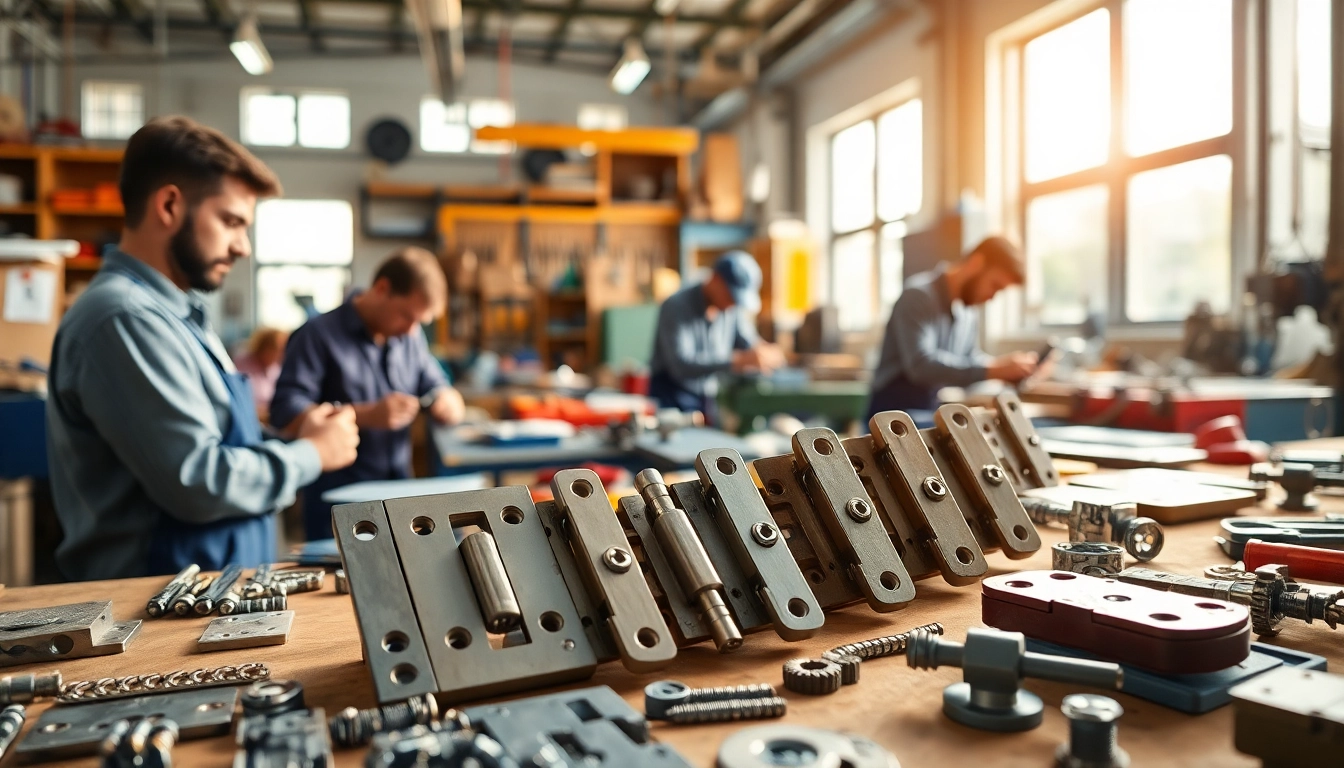Understanding Cabinet Hinge Types
Overview of Common Cabinet Hinges
Cabinet hinges are essential components that allow for seamless movement of doors and lids while ensuring durability and functionality. The various types of hinges can be categorized based on their design, mechanism, and application. Common types include:
- Concealed Hinges: Often used in modern cabinetry, concealed hinges are hidden from view when the cabinet is closed, offering a clean aesthetic. They are commonly adjustable, allowing for a precise fit.
- Overlay Hinges: These hinges are mounted on the outside of the cabinet and work well with overlay doors that cover the cabinet frame entirely.
- Inset Hinges: Mounted inside the cabinet frame, inset hinges are ideal for cabinets where doors fit flush with the cabinet front.
- Euro Hinges: A popular choice for modern cabinets, these hinges offer a reliable and adjustable solution and are also covered by the cabinet door.
- Butt Hinges: Common in traditional cabinetry, butt hinges are attached to the exterior of the door and frame, allowing for a wide swing range.
Differences Between Concealed and Exposed Hinges
When deciding between concealed and exposed hinges for a cabinet, several factors come into play:
- Aesthetics: Concealed hinges offer a sleek look, suitable for modern designs, whereas exposed hinges can be decorative, complementing traditional themes.
- Installation: Concealed hinges often require more precise cutting and installation due to their hidden nature. Exposed hinges are simpler to install, typically requiring minimal adjustments.
- Functionality: Both hinge types can be designed for various functionalities, including soft-close mechanisms. The choice often depends on user preference and cabinetry design.
Choosing the Right Hinge for Your Cabinet
Choosing the right hinge involves considering the cabinet’s design, weight, and usage frequency. Here are some essential tips:
- Weight Capacity: Ensure the hinge can support the weight of the door. For heavier cabinet doors, heavy-duty hinges are necessary.
- Door Overlay: Measure the overlay to choose the appropriate hinge type for the design, whether inset or overlay.
- Hinge Material: Select high-quality materials that resist corrosion and wear, particularly in kitchens or bathrooms.
Leading Cabinet Hinge Manufacturers
Top Brands in the Market
The market for cabinet hinges is competitive, with various manufacturers offering specialized products. Some of the top names include:
- Blum: Known for innovative hinge technologies, Blum offers a wide selection of concealed hinges that focus on ease of installation and smooth operation.
- Hettich: This manufacturer focuses on functional solutions, ensuring that their hinges cater to global design needs, offering both quality and aesthetics.
- Grass: Grass manufactures a diverse portfolio of hinges designed for both residential and commercial applications, ensuring versatility and reliability.
- Amerock: Offering aesthetically appealing designs, Amerock specializes in decorative hinges, adding style to functionality.
- Tallsen: Cabinet Hinge Manufacturers like Tallsen are gaining recognition for providing high-quality, cost-effective products that blend functionality with design.
What Sets Tallsen Apart?
As a leading manufacturer, Tallsen distinguishes itself through a combination of quality, innovation, and customer-centric approach:
- Comprehensive Catalog: Tallsen offers a wide range of cabinet hinge solutions, catering to diverse culinary and living space designs.
- Engagement in Design Innovation: Committed to research and development, Tallsen regularly updates product lines to incorporate the latest technologies in cabinetry design.
- Focus on Customer Experience: Tallsen prioritizes customer feedback, using it to drive both product development and after-sale services.
Comparing Features and Prices
When comparing cabinet hinges from various manufacturers, price is often a decisive factor. However, it’s essential to consider the following features alongside pricing:
- Materials Used: Higher-quality hinges may come with a higher price point, but they offer better durability.
- Weight Ratings: Consider the weight ratings provided by manufacturers, as they indicate the robustness of the hinge.
- Special Features: Look for innovations like soft-close mechanisms or self-closing hinges, which can improve usability and longevity.
Benefits of Quality Cabinet Hinges
Durability and Longevity in Design
Investing in high-quality cabinet hinges ensures prolonged lifespan and minimal maintenance. Durable materials such as stainless steel or brass resist corrosion and wear, making them ideal for high-usage environments. With proper installation, quality hinges can last years without needing replacement.
Enhanced Functionality and Usability
Quality cabinet hinges contribute significantly to the usability of cabinets. Features such as soft-close or self-closing mechanisms improve functionality by preventing slamming and ensuring smooth operation. This aspect is particularly essential in kitchen environments where frequent access is required.
Impact on Overall Cabinet Aesthetics
The right hinges can enhance the overall look and feel of cabinetry. Concealed hinges provide a clean look, while decorative exposed hinges can become a stylish feature. This aesthetic consideration can elevate a space, making it more visually appealing.
Best Practices for Selecting Cabinet Hinges
Factors to Consider When Buying
When purchasing cabinet hinges, buyers should keep several factors in mind. Quality, material, type, and brand reputation all play a critical role:
- Project Requirements: Understand the specific needs based on the cabinetry type and usage.
- Design Compatibility: Choose hinges that harmonize with the overall aesthetics of the cabinetry.
- Regulatory Standards: Consider any industry standards or safety regulations relevant to cabinetry in commercial settings.
Installation Tips for Optimal Performance
Proper installation is vital for the functionality of cabinet hinges. Following these tips can lead to optimal performance:
- Measure Accurately: Take precise measurements to ensure a perfect fit.
- Follow Manufacturer Instructions: Each hinge may have specific installation guidelines that should be adhered to for best performance.
- Use Quality Tools: Ensure that the installation tools are appropriate and in good condition to facilitate a smooth installation process.
Maintenance for Longevity
Regular maintenance of cabinet hinges promotes longevity and smooth operation. Here are some essential maintenance practices:
- Cleaning: Regularly clean hinges to prevent grime buildup that can impair functionality.
- Lubrication: Apply lubricant to hinges periodically to ensure smooth movement and prevent squeaking.
- Inspection: Regularly check hinges for signs of wear or damage to address issues before they become significant problems.
Trends in Cabinet Hinge Manufacturing
Recent Innovations in Hinge Technology
As technology evolves, so does cabinet hinge design. Recent innovations include:
- Soft-Close Mechanisms: These hinge systems prevent slamming and promote quieter operation, enhancing user experience.
- Self-Closing Hinges: Designed to automatically pull cabinet doors shut, they improve convenience in high-use areas.
- Adjustable Hinge Designs: Many modern hinges incorporate adjustable components, allowing for precise alignment after installation.
Environmental Considerations in Manufacturing
The cabinet hinge manufacturing industry is increasingly aware of its environmental footprint. Leading manufacturers are implementing sustainable practices, including:
- Recyclable Materials: Using recyclable materials in hinge production reduces waste and promotes sustainability.
- Waste Reduction Techniques: Manufacturers are focusing on reducing waste during production processes.
- Energy Efficiency: Improved energy efficiency in manufacturing minimizes environmental impacts.
Future Directions for Cabinet Hinge Design
The future of cabinet hinge design is bright, with trends moving towards even greater customization and smarter technology integration. Anticipated developments include:
- Smart Hinges: Integration of digital monitoring systems to track usage and alert for maintenance needs.
- Personal Customization: Offering more tailored designs to suit specific customer preferences, including color finishes and materials.
- Modular Systems: Development of modular hinge systems that allow easy modification and replacement to enhance usability.



